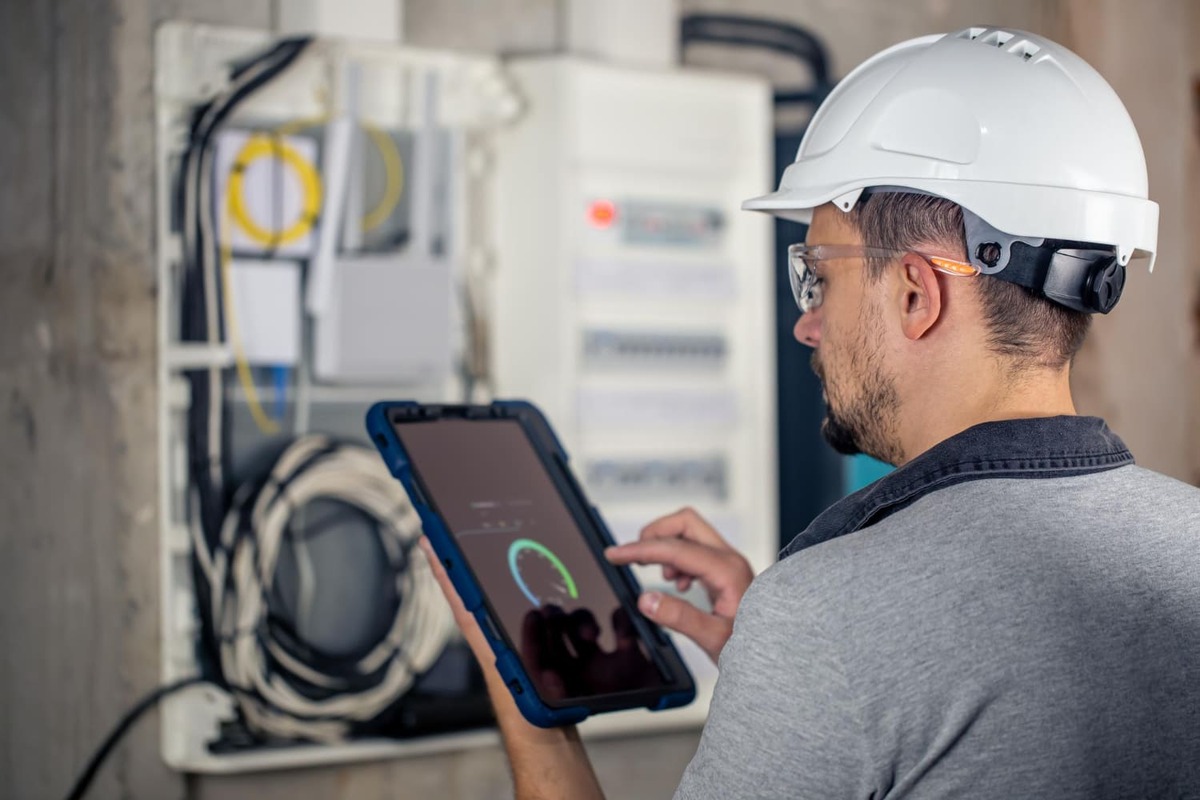Predictive maintenance IoT refers to using Internet of Things (IoT) sensors and analytics to monitor the health of equipment and infrastructure in real time. In construction, this means outfitting machinery (e.g., cranes, excavators, generators) and even structural elements with connected sensors. These devices continuously collect data on parameters like vibration, temperature, pressure, and performance. Advanced algorithms then analyze this data to predict when components might fail or require service. Instead of fixing equipment only after a breakdown (reactive maintenance) or servicing on a fixed schedule without regard to actual condition (preventive maintenance), predictive maintenance uses data-driven insights to perform maintenance just in time before a failure occurs.
This approach has proven especially valuable on construction sites, where unplanned downtime can derail tight project schedules. Studies have shown that implementing IoT-based predictive maintenance can reduce unexpected equipment downtime by around 25–30%, improving overall asset availability. Some construction firms have even reported up to 70% less unplanned machinery downtime by shifting to predictive strategies. The result is that projects see fewer work stoppages, and maintenance crews can address issues at optimal times (for example, during off-peak hours) instead of in the middle of critical operations. In short, Predictive Maintenance IoT enables construction teams to fix problems before they cause costly delays.
Table of Contents
Key Benefits for Construction Projects
-
Reduced Unplanned Downtime: By catching early warning signs of equipment trouble, IoT systems help avoid sudden breakdowns. Fewer breakdowns mean construction crews experience far fewer interruptions, keeping the project timeline on track. Every hour of avoided downtime directly boosts productivity on site.
-
Cost Savings: Preventing major equipment failures yields significant cost savings. Construction companies save on emergency repair costs, overtime labor, and costly rental of replacement equipment. Avoiding a single catastrophic machine failure (such as a crane motor burnout) can save tens of thousands of dollars in repair and delay costs. One case study found a commercial contractor saved about $100,000 in a year by using predictive maintenance to avert breakdowns.
-
Improved Safety: Well-maintained machinery is safer. IoT monitoring often catches issues (like excessive vibrations or overheating) that could lead to unsafe conditions if left unchecked. By addressing these issues proactively, the risk of accidents caused by equipment failure is reduced. Workers spend less time dealing with emergency fixes in hazardous situations.
-
Extended Equipment Life: Continuous monitoring and timely maintenance tend to extend the lifespan of construction equipment. Machines that are serviced right when needed (rather than running to failure or being over-serviced) experience less wear and tear. In the long run, contractors get more years of reliable service from their assets, deferring capital expenditures on new equipment.
-
Better Resource Planning: Predictive maintenance IoT platforms often integrate with maintenance scheduling systems. This allows project managers to plan repairs during scheduled downtime or between project phases. The maintenance team gets alerts and can prepare the needed parts and technicians in advance. This optimized scheduling means maintenance happens with minimal impact on project progress.

How Predictive Maintenance IoT Reduces Unplanned Downtime in Construction: 4 Case Studies
With these benefits in mind, the following case studies demonstrate how Predictive Maintenance IoT has been applied in various European construction scenarios to dramatically reduce unplanned downtime.
Case Study 1: IoT Keeps a London Skyscraper Project on Schedule (Commercial Construction)
Project Overview: A major commercial high-rise construction project in London, UK faced the challenge of keeping its tight schedule on track. The project relied on several tower cranes and heavy lifting equipment to operate continuously to meet deadlines. In past projects, unexpected crane breakdowns or machinery faults had caused costly delays. Determined to avoid these issues, the contractor adopted an IoT-based predictive maintenance program for their critical equipment on this skyscraper build.
IoT Implementation: The cranes, excavators, and generators at the site were equipped with a network of smart sensors connected via telematics. These IoT devices monitored metrics such as motor temperatures, oil pressure, vibrations in crane gearboxes, and electrical load on generators. All data streamed to a cloud dashboard monitored by both the site managers and an off-site analytics team. Machine learning algorithms analyzed the real-time data to detect anomalies or trends indicating developing faults. For example, a slight increase in vibration and heat in a crane’s hoist motor might indicate bearing wear. If any parameter crossed a safety threshold or showed unusual patterns, the system would trigger an alert.
Results: Over the 18-month construction schedule, this IoT predictive maintenance approach proved invaluable. Early in the project, sensors on one tower crane detected abnormal vibrations and temperature rises in the crane’s main winch motor. The system flagged this as a potential issue, and maintenance was scheduled for the next Sunday (a non-working day on site). The inspection found a deteriorating bearing and replaced it, preventing a failure. No crane downtime occurred during working hours, whereas a sudden failure could have halted lifting operations for 2–3 days. Across all equipment, the project avoided numerous breakdowns.
In total, the contractor reported that in just the first 8 months, they averted approximately 176 hours of unplanned downtime (about 22 hours per month of additional machine availability). This meant tasks that would have stalled waiting for repairs were completed on time. The consistent equipment uptime kept the skyscraper’s construction on schedule, avoiding delay penalties. Additionally, maintenance costs were predictable and lower – the team wasn’t scrambling to overnight ship parts or rent emergency equipment. The success of this London high-rise project demonstrated how predictive maintenance IoT could pay off in the commercial building sector, ensuring that critical machines like cranes are almost always ready when needed.
Suggested article to read: Predictive Maintenance in Buildings; Ultimate Guide 2024

Case Study 2: Fleet-Wide IoT Monitoring in the Netherlands Eliminates Critical Failures (Infrastructure Construction)
Background: A civil construction firm in the Netherlands undertook multiple infrastructure projects (including highway expansions and flood defense constructions) where heavy machinery uptime was mission-critical. They operated a fleet of over 100 construction machines—ranging from large excavators and loaders to paving machines. Previously, this contractor had suffered several major equipment failures that caused significant project delays. One recurring issue was transmission failures in large earthmoving trucks; a single transmission breakdown could put a dump truck out of service for a week, causing bottlenecks in earthworks. To combat this, the company invested in an IoT-based health monitoring service provided by their equipment manufacturer.
IoT Implementation: Starting in 2015, the firm equipped its entire heavy machinery fleet with IoT telematics devices. These sensors continuously sent performance data (engine/transmission temperature, hydraulic pressure, vibration signatures, etc.) to a centralized analysis center. The equipment manufacturer’s monitoring center analysts (and AI algorithms) would examine the data for warning signs. For example, unusual spikes in gearbox temperature or slight delays in gearshift response were flagged as indicators of impending transmission trouble. The system would then notify the contractor’s maintenance managers with a diagnosis and recommended action. In many cases, the alert would come through days or weeks before a failure might occur, allowing planned maintenance to be arranged.
Results: The impact was dramatic. In the year prior to IoT monitoring, this fleet had experienced six major transmission failures among their machines, each incident leading to extended downtime and expensive repairs. After implementing the IoT predictive maintenance program, transmission failures dropped to zero in the subsequent year. By catching early signs of wear (like degraded oil quality and abnormal vibrations), the team performed timely repairs or part replacements during scheduled maintenance windows – before any breakdown happened on site.
This elimination of a common failure mode meant none of the projects under way suffered delays from that issue. Overall unplanned downtime across the 100+ machines fell significantly; the company noted that even other components (engine cooling systems, hydraulic pumps, etc.) had far fewer surprise failures thanks to early detection. In terms of productivity, the avoidance of those six major failures alone saved an estimated dozens of workdays that would have been lost. Projects such as highway construction stayed on schedule, as critical equipment was reliably available when needed.
The IoT monitoring initiative not only prevented costly repairs but also improved the confidence of project managers when planning work – they could trust their machines to perform without unexpected interruptions. The Netherlands case illustrates how scaling predictive maintenance IoT across an entire fleet can yield huge reliability gains in infrastructure construction.

Case Study 3: Smart Maintenance in a Swedish Housing Development (Residential Construction)
Project Overview: A Swedish construction company was building a large residential housing development on the outskirts of Stockholm – a project involving multiple apartment blocks and community facilities. Residential construction projects typically utilize tower cranes, concrete mixers, forklifts, and various smaller machines on site. Any downtime of key equipment (for instance, a crane used to lift prefab panels or a concrete pump during foundation pours) could idle crews and disrupt tightly coordinated schedules. The company decided to leverage predictive maintenance IoT to ensure smooth operations throughout the build, even though such technology is less common in mid-scale residential projects.
IoT Implementation: The construction team installed IoT sensors and telemetry units on their primary equipment: the site’s tower crane, the concrete batching plant, and portable generators. The tower crane, for example, was fitted with sensors on its electric motors, gearbox, and structural connections. These devices monitored strain and motor health indicators, sending data daily into a cloud platform. Similarly, the concrete mixer’s drum motor had temperature and vibration monitors.
A specialized software platform aggregated all this data and applied predictive analytics. Because this was a pilot program for the company, they worked closely with an IoT vendor who provided a user-friendly dashboard. Site managers received weekly health reports for each machine, and instant SMS alerts if any parameter went out of range. The analytics could compare current performance to historical baselines and to manufacturer specs, identifying subtle changes. For instance, the tower crane’s slew motor showed a gradual increase in energy draw and slight vibration irregularities – the algorithm flagged this trend as a possible developing issue.
Results: Predictive maintenance IoT proved its value by preventing delays in the housing project. Midway through construction, the system issued an alert about the tower crane’s slew (rotation) mechanism. The data indicated growing friction in the turntable bearing. Acting on this warning, the maintenance crew scheduled a brief outage on a weekend to lubricate and adjust the bearing and replace a worn seal. This proactive fix averted a potential breakdown – the crane never experienced any failure during working hours. In fact, throughout the project’s duration, the company reported near-zero unplanned downtime of critical equipment.
Compared to similar past projects, they saw about a 30% reduction in equipment-related downtime. Tasks like lifting roof trusses and pouring concrete slabs all happened on their planned dates, with no waiting on repairs. By ensuring the reliability of machinery, the project finished on time and within budget. Another benefit was that the site team could maintain a steady workflow without the stop-start unpredictability that often plagues construction jobs.
Contractors also noted improved crew morale and efficiency – workers could trust that the tools and machines would be available when needed, streamlining daily planning. This case underlines that even in residential construction, where profit margins can be tight, adopting IoT for predictive maintenance can pay off by keeping the project timeline intact and avoiding surprise equipment rental or repair costs.
Case Study 4: IoT Sensors Protect the Queensferry Bridge in Scotland (Infrastructure Maintenance)
Context: Not all downtime in construction relates to active building sites; maintaining completed structures is equally critical. The Queensferry Crossing in Scotland – a massive cable-stayed bridge connecting Edinburgh to Fife – is a vital piece of infrastructure that opened a few years ago. Soon after its opening, the bridge operators faced unexpected closures due to ice accumulation and other extreme weather impacts. Unplanned downtime of a bridge (closure to traffic) has huge consequences for transportation and safety. To better manage the bridge’s health and minimize closures, engineers turned to an IoT-powered structural health monitoring system, a form of predictive maintenance for infrastructure.
IoT Implementation: A network of smart sensors was installed across the Queensferry Bridge’s structure. These included accelerometers and strain gauges on critical elements like the suspension cables, bridge deck, and support pillars. The sensors continuously measure vibrations, stress, tilt, temperature, and even detect ice formation conditions. All sensor data streams to a central control system in real time.
Using this constant flow of information, predictive analytics software learns the normal behavior of the bridge under various conditions (traffic loads, wind, temperature changes). When the system detects an anomaly or unusual trend – for example, an abnormal vibration pattern in one of the cables during high winds – it immediately alerts bridge engineers. The IoT monitoring setup essentially gives an early warning for any structural issues or dangerous conditions developing on the bridge.

Results: The predictive monitoring system has been instrumental in reducing unplanned downtime and preventing damage to this infrastructure. For instance, during a severe winter storm, sensors noted rapid temperature drops and subtle vibrations indicative of ice forming on the cables. Armed with this data, operators proactively closed the Queensferry Bridge to traffic for a few hours as a precaution and activated de-icing measures. As a result, they prevented what could have been a much longer closure or even physical damage (falling ice can damage vehicles or the bridge itself).
In another instance, the sensor array picked up an increasing strain on a support joint that was beyond expected levels. Maintenance crews were dispatched to inspect and reinforce the joint before any crack or failure occurred. Because issues are caught early, the bridge has avoided major structural incidents that would require lengthy repairs.
Since implementing IoT monitoring, every maintenance intervention on the bridge could be planned deliberately instead of reacting to emergencies. The net effect is that the Queensferry Crossing has experienced far fewer unexpected closures. Any necessary shutdowns for maintenance are short, controlled, and often scheduled at off-peak times, minimizing disruption. This case study shows how predictive maintenance IoT isn’t just for machinery – it can safeguard critical infrastructure, preserving safety and uptime. By continuously “listening” to the bridge through sensors, engineers ensure the structure remains sound and open to the public, exemplifying how IoT reduces downtime even beyond the construction phase.
FAQs
How does Predictive Maintenance IoT reduce unplanned downtime in construction?
- Answer: Predictive Maintenance IoT reduces downtime by continuously monitoring equipment health and alerting teams to issues before failures happen. IoT sensors collect data on machinery (like temperature, vibration, or oil condition) in real time. Smart analytics then identify early warning signs of wear or malfunction. For example, if a generator shows an abnormal temperature spike, the system flags it so mechanics can fix the problem proactively. By addressing potential failures during planned maintenance windows (instead of after a breakdown on site), construction firms avoid the sudden stoppages that cause unplanned downtime. In short, the technology gives an advance heads-up, allowing teams to repair or service equipment prior to a critical failure, thereby keeping the project running smoothly.
What are examples of IoT devices used for predictive maintenance on construction sites?
- Answer: Construction sites use a variety of IoT devices for predictive maintenance. Common examples include vibration and temperature sensors attached to heavy machinery (such as excavators, cranes, and compressors) to detect unusual vibrations or overheating components. Oil quality and pressure sensors are used on engines and hydraulics to monitor for signs of contamination or leaks. Telematics units with GPS and accelerometers not only track equipment location but also measure usage patterns and mechanical stress. In addition, some sites use smart wearables (helmets or vests) on workers and environmental sensors (measuring dust, noise, or structural strain) – these indirectly aid maintenance by monitoring conditions that affect machines (for instance, alerting if vibration levels in the ground might impact nearby equipment). All these IoT devices connect to a central system, which aggregates the data for analysis. By deploying these sensors, construction companies gain a detailed, continuous picture of equipment condition, enabling truly predictive maintenance.
Which types of construction projects benefit most from predictive maintenance IoT?
- Answer: Nearly all types of construction projects can benefit, but those with heavy equipment usage or critical uptime requirements see the most value from predictive maintenance IoT. Large-scale commercial projects and high-rise construction benefit because they rely on key machines (like tower cranes, hoists, and concrete pumps) where any failure can halt the whole project. Infrastructure and civil engineering works – such as road building, tunneling, and bridge construction – also gain huge advantages, since they employ fleets of specialized machinery often operating in remote or continuous operations. In these cases, predictive IoT systems keep bulldozers, tunneling machines, and asphalt pavers running reliably, which is essential to meeting project deadlines. Even residential developments and smaller projects profit by avoiding delays, though the impact is most pronounced on complex, equipment-intensive jobs. Additionally, projects in harsh environments or remote locations (where repair resources are far away) benefit greatly – IoT monitoring helps plan maintenance so that parts and technicians are available when needed, preventing extended downtimes. Ultimately, any construction project that values high equipment uptime and efficient scheduling will benefit from predictive maintenance IoT, but the larger and more equipment-dependent the project, the more crucial this technology becomes.
Is it true that predictive maintenance IoT can save construction companies money as well as time?
- Answer: Yes, absolutely. Predictive maintenance IoT saves construction companies money in multiple ways while also saving time. First, by preventing major breakdowns, companies avoid the direct costs of emergency repairs – overnight shipping for parts, hiring specialist technicians on short notice, or renting replacement equipment, all of which are very expensive. Second, minimising unplanned downtime means crews and subcontractors aren’t sitting idle (and still on the payroll) waiting for repairs; this improves labor productivity and reduces wasted budget on stalled work. There’s also a savings in avoiding project delay penalties or liquidated damages that can occur if a project misses its deadline due to equipment issues. Over the long term, keeping machinery in healthier condition through timely maintenance extends its lifespan, so firms spend less on buying new equipment. While there is an upfront investment in IoT sensors and systems, the return on investment is strong – case studies have shown that the reduction in downtime and maintenance emergencies can save companies tens of thousands of dollars per project. In summary, predictive maintenance IoT not only keeps projects on schedule (saving time), but it also cuts surprise costs and optimizes maintenance spending (saving money). Most construction companies find that these savings far outweigh the implementation costs.
Conclusion
Across commercial building sites, residential developments, and infrastructure projects, these case studies highlight a common theme: Predictive Maintenance IoT significantly reduces unplanned downtime in construction. By leveraging real-time data from sensors, construction teams can fix problems on their terms instead of scrambling after a failure. The results are tangible – project schedules stay intact, costly delays are avoided, and both equipment and structures remain safer and more reliable. In essence, IoT-enabled predictive maintenance turns maintenance from a chaotic, reactive chore into a strategic, proactive advantage.
Companies that have adopted these technologies in Europe have seen improved productivity, lower costs, and increased confidence in their project delivery. As construction continues to digitalize, predictive maintenance powered by IoT stands out as a proven way to keep the cranes swinging, the trucks running, and the bridges open – all with fewer unexpected interruptions. For the construction industry, that means building more efficiently and effectively than ever before.
Resources:
-
Deloitte. (2019). Predictive Maintenance and the Smart Construction Site. Industry Report Excerpt – Cited statistic on up to 70% downtime reduction with predictive maintenance in construction.
-
Volvo Construction Equipment. (2018). Proactive Monitoring Case Studies (UK & Netherlands). Available at: – Real-world data on hours of downtime avoided and elimination of transmission failures through IoT monitoring.
-
Scientific Reports – Ding, L., et al. (2024). IoT for Safety and Efficiency in Construction Sites. Nature Scientific Reports, 14, 78931. (Contains data on 25–30% downtime reduction and 10–15% higher asset utilization with sensor-based predictive maintenance).
-
Zepth. (2023). The Role of Predictive Maintenance in Construction Equipment Management. Available at: https://www.zepth.com – Overview of benefits; notes a case of $100k savings in one year and productivity gains of ~25%.
-
AZoBuild – Singh, A. (2025). Predictive Maintenance in Construction: A Proactive Approach to Efficiency and Safety. Available at: https://www.azobuild.com – General explanation of predictive maintenance technologies and safety benefits in construction.
-
Next Industries. (2023). Case Study: How IoT Monitoring Prevented Damage on a Historic Bridge. Available at: https://www.nextind.eu – Describes the Queensferry Bridge sensor deployment and how early warnings averted structural damage and unplanned closure.
-
Tunneling Online – Newton, E. (2024). What’s New in Tunnel Boring Machine Technology? Available at: https://tunnelingonline.com – Discusses IoT and predictive maintenance usage in modern TBMs to reduce maintenance times and costs.
-
Construction Tech Review. (2025). How IoT is Powering Smart Construction Sites. Available at: https://www.constructiontechreview.com – Highlights IoT trends in European construction, including predictive maintenance becoming standard to lower breakdowns and extend equipment life.
For all the pictures: Freepik
Suggested article for reading:
Top 7 Trends in Architecture Embracing Sustainability in 2025
Top 5 Trends in Security Automation for Smart Buildings
Key Strategies for Risk Management in Construction; 2025
Top 12 Must-See Architectural Projects in Milan
AI-designed Architecture Projects that Redefine Design in 2025
Top 15 Urban Design Tools for 2025
Future of Construction Management: 10 Trends you Need to Know
How Virtual Construction Assistants Improve Project Management; 2025




